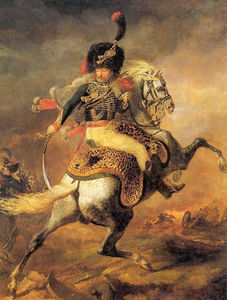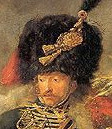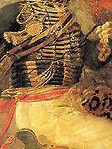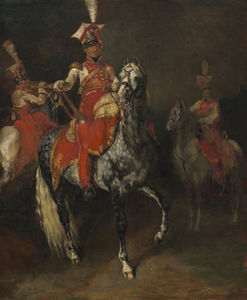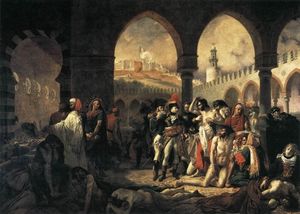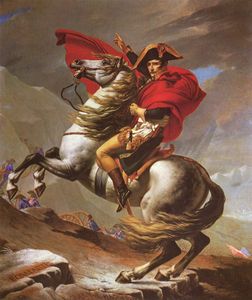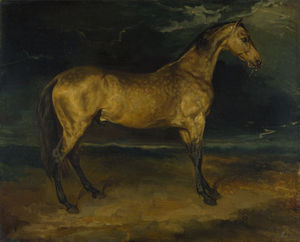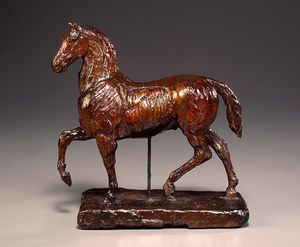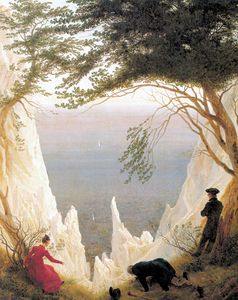The Charging Chasseur
- Date of Creation:
- circa 1812
- Height (cm):
- 349.00
- Length (cm):
- 266.00
- Medium:
- Oil
- Support:
- Canvas
- Subject:
- Figure
- Art Movement:
- Romanticism
- Created by:
- Current Location:
- Paris, France
- Displayed at:
- Musée du Louvre
- Owner:
- Musée du Louvre
- The Charging Chasseur Page's Content
- Story / Theme
- Analysis
- Related Paintings
- Artist
- Art Period
- Bibliography
The Charging Chasseur Story / Theme
The Charging Chass&egravzzz;ur was painted around 1812 and it shows a cavalry member of Napoleon's forces on horseback preparing for attack. Yet, the horse seems to be rearing away from an unseen attacker.
This work was very different from other Napoleonic battle scenes due to its unique composition.
This painting is symbolic of French Romanticism and has a motif similar to Jacques Louis David's Napoleon Crossing the Alps (see Related Paintings below). However, in this piece, there are various non-classical characteristics such as its dramatic diagonal arrangement and vigorous paint handling.
The Charging Chasseur was the first work that Theodore Géricault exhibited. Afterwards, the artist continued moving away from classicism and this was evident in works such as his masterpiece The Raft of the Medusa of 1819.
The Charging Chasseur Analysis
Paintings such as The Charging Chasseur are recognizable by their individuality. This was a major tenet of Gericault's works, which draws him tightly into the Romantic fold.
Composition:
Géricault seems to have been preoccupied in the painting itself, in a lively handling of pigments and the working out of his design.
He would sketch individual portions of the overall composition and then paint it fully before moving onto the next section of the canvas. This gave each body or section of the composition the appearance of being its own miniature composition, lending an unparalleled physicality to each figure.
Color palette:
Notice the soft spots of color on the center horse's muzzle and the long, rippling streaks in its tail. Géricault's trumpeter and his mount reflect elements taken from Rubens and Van Dyck.
The energetic styles of these baroque artists and their emphasis of color were well matched in this piece.
Géricault typically used a warm palette here, focusing heavy on the vermillion, ochre, light red, peach, black, and contrasting cream or beige to highlight colored spots.
Brushstroke:
Géricault utilized small brushes, applying the paint in precise, fluid strokes that allowed little time or room for correction.
The Charging Chasseur Related Paintings
The Charging Chasseur Artist
The Charging Chasseur was Géricault's first major work exhibited at the Paris Salon of 1812. The influence of Rubens' style is evident in this piece as is Géricault's penchant for depicting contemporary subject matter.
Following the success of this work, the artist spent the next few years creating a series of small studies of horses and cavalrymen.
Frail, brooding and sensitive, Géricault was as romantic as a Romantic painter could be. While he began his career with grand military statements for the Emperor Napoleon, it was his later works, such as The Charging Chasseur with their emotional brutality and raw empathy, which captured the hearts of audiences for generations.
Géricault's later works were often iconic in the era in which he lived, forging a new emphasis on raw emotion and sharply veering away from the refined compositional studies of Neoclassicism.
Unfortunately, the artist's death at an early age prevents us from knowing how much further into the depths of humanity he was capable of plunging. However, the work he did leave was of great importance to the Romantic Movement.
The Charging Chasseur Art Period
Romanticism is sometimes viewed as a reaction to its more serious predecessor, the Neoclassical movement. As Neoclassical artists focused on properly accounting history through close attention to detail, Romantic artists flirted with themes of man's self glorification, man's part in nature, divinity found in nature, and emotion.
Romantic painters such as Friedrich and Delacroix were part of a complex multimedia philosophical movement, involving the literary, visual, and intellectual arts.
Romanticism emphasizes the individual sense of self, creativity, imagination, and the value of art to make a statement. This emphasis on the individual is reflected in the ideas of self-realization through the act of contemplating nature.
There is the idea that the individual can only directly understand nature, free from society. Peace and salvation come through the individual rather than through political movements.
The Charging Chasseur Bibliography
To read more about Gericault and his works please refer to the following recommended sources.
• Alhadeff, Albert. The Raft of the Medusa: Gericault, Art, and Race. Prestel, 2002
• Athanassoglou-Kallmyer, Nina M. Theodore Gericault. Phaidon Press Ltd; Ill edition, 2010
• Eitner, Lorenz E. A. Gericault: His Life and Work. Orbis Publishing, 1983
• Eitner, Lorenz E. A. & Nash, Steven A. Gericault: 1791-1824. Fine Arts Museum of San, 1989
• Grunchec, Philippe. Gericault's Horses: Drawings and Watercolours. Philip Wilson Publishers Ltd. , 1984
• Grunchec, Philippe. Master Drawings by Gericault. Art Services Intl. , 1985
• Sagne, Jean. Géricault. Fayard, 1991
• Wheelock, Whitney. Gericault in Italy. Yale University Press, 1997

